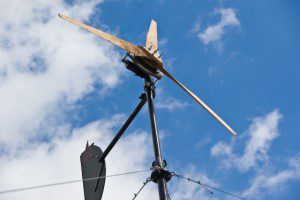
It’s only natural that interest in generating electric power at home is going up. Renewable energy methods that can be implemented at home, especially solar and wind, are dropping in price. At the same time, the cost of fossil fuels, especially oil, keeps going up. Which type of system you choose to install will depend in part on where you live. Some places are better suited for solar power because of the reliability and strength of sunlight. In others, wind power is a better choice because of high prevailing winds blowing not too far off the ground. But while producing your own electricity can save you a lot of money in electric bills, the cost of installing such a system up front can be a little daunting.
If you do the work of installing your wind turbines yourself rather than hiring a contractor, that shaves a good bit off the price. But the labor to install a wind power system, although not cheap, isn’t the only part of the cost. There’s also the cost of the turbine itself, its housing, and the tower to push the turbine blades up where they can catch the wind. A pre-
Wouldn’t it be great to cut that cost further by making your own wind turbines from scratch? Can that be done? Indeed it can.
Wind Turbine Components
A wind turbine generator is made from the following parts: the blades (you can see these on any commercial wind turbine; they look like an airplane propeller without the plane); a mounting for the blades that keeps them turned to face the wind; a tower that lifts the assembly up high enough to catch the wind; a drive train; and a generator.
The best way to build the drive train is to make use of direct drive technology by installing the generator right behind the blades. That way you don’t have to bother with complicated gear mechanisms to transmit the energy down to the ground, which saves a lot in maintenance headaches. Does this sound like it’s going to be a lot of work? Well, it is –
Plans
The great thing about wind power becoming so popular is that you can find plans for making your own wind turbines on line for free. You can also find detailed tutorials on how to build homemade wind turbines on YouTube. It’s all just a search away, so if you find yourself inspired by this article to look more deeply into the matter, that won’t be hard at all! You can also find plans in great detail for a small amount of money, and those might be a little easier to follow, or they might not. The main thing to understand is that this isn’t some kind of big classified secret, wind electricity is a technology that’s been around for many years, and the information is available without having to pay an arm and a leg for it.
Tools
Making your own wind power requires a few tools, of course. You’ll need a jigsaw, a small grinder, some wrenches and a socket set, screwdrivers, sandpaper, and a sharp knife. Lubricating oil is also a good idea.
Turbine Blades
You could make your wind turbine blades out of wood –
The easiest approach is to use six-
Generator
Behind the blades and attached to the same shaft is a generator. Now, the interesting thing here is that since you’re using a simple form of direct drive, a commercial generator actually isn’t a very good choice. Most commercial generators are designed to be spun at a very high speed, and windmills use a gear drive to increase the speed at which the generator spins. But your generator is going to be spinning at the same rate as your blades, and that’s relatively slow as generators go.
A generator is just an electric motor driven in reverse. Both use the same technology. A motor gets fed electricity and turns it into motion. A generator gets fed motion and turns it into electricity. The principle is the same no matter which direction you use. What that means is that you can use an electric motor for a generator. You just need to find a permanent magnet type motor of a certain type. What you want is one with a low rpm to high voltage rating, because that’s exactly what you’re going to be doing: running it at low revolutions per minute, and turning that into the highest voltage you can. The same thing that makes the motor somewhat inefficient as a motor makes it the best choice for your generator.
It’s a good idea to get some practice making each part of the design before you try to put it all together. It’s not rocket science exactly, but making your own wind turbine does require some acquired knowledge and skill. In addition to making the blades and drive shaft and turning a motor into a generator, you’ll need to do some electrical work, connecting your turbine to the equipment needed for an electrical production system. Those parts aren’t hard to find, either, and you can go with either a grid-
But the design isn’t complicated and the skills are not that difficult to acquire. The electrical work isn’t sophisticated electronics but quite simple. Even if you decide in the end that you’re more comfortable hiring the wiring work done, you’ll still have gained some valuable knowledge and any of it that you can do yourself will save you money.
